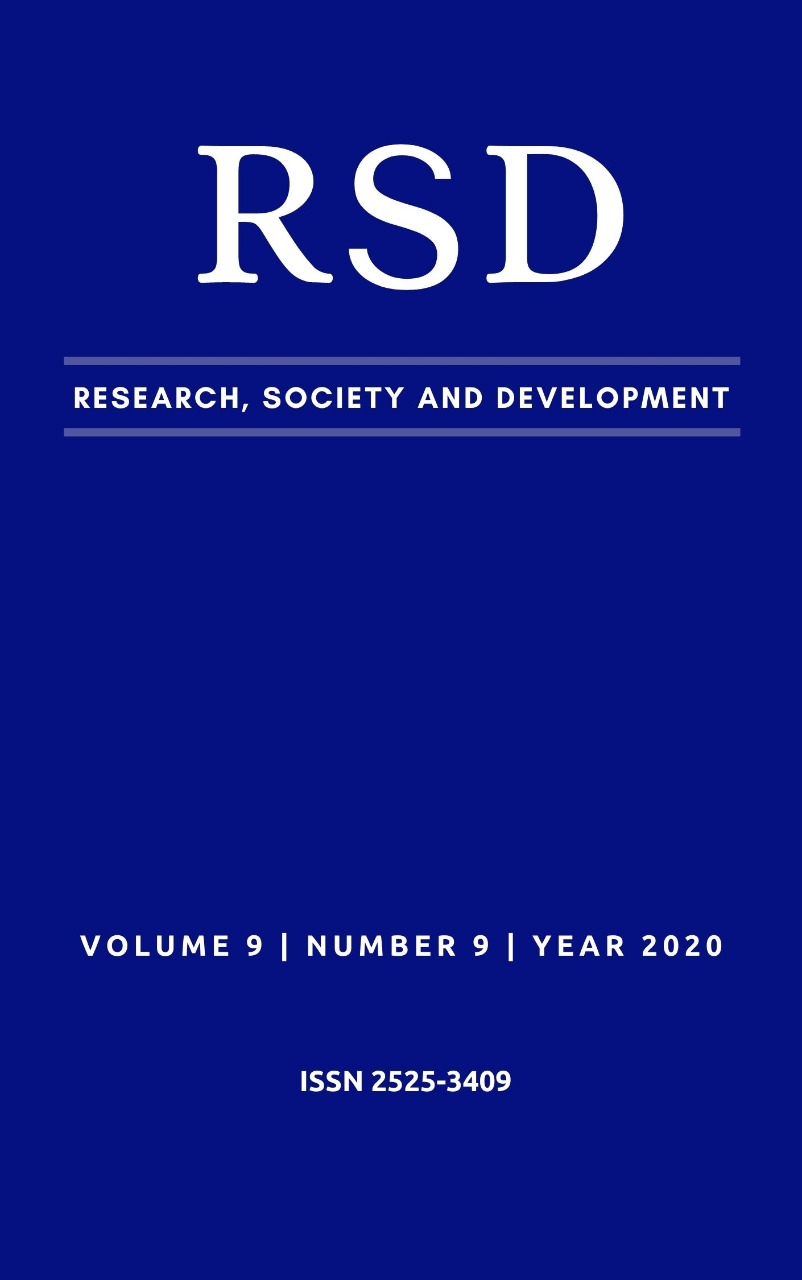Toxina botulínica tipo A en la sonrisa gingival debido a la hipercontracción muscular
DOI:
https://doi.org/10.33448/rsd-v9i9.6430Palabras clave:
Toxina botulínica, Sonrisa gingival, Botox.Resumen
La sonrisa gingival se caracteriza por la exposición excesiva de dientes y encías durante la contracción de los grupos musculares en los tercios medio e inferior de la cara y está presente en muchos pacientes, lo que provoca una falta de armonía en la estética facial. El objetivo del trabajo fue presentar un informe de caso y demostrar el tratamiento de la sonrisa gingival con el uso de toxina botulínica tipo A, causada por hipercontracción muscular. El paciente se sometió a exámenes clínicos y fotográficos para diagnosticar los músculos involucrados. El paciente recibió la toxina boutulínica diluida y se aplicó a los músculos lenta y continuamente en los puntos predemarcados, con 2U en cada punto, 4U en cada lado, totalizando 8U bilateralmente. Es importante tener en cuenta que el objetivo se logró con el uso de toxina botulínica sin la necesidad de procedimientos quirúrgico sen el tejido óseo y el tejido gingival. Llegamos a la conclusión de que la toxina botulínica tipo A fue un método utilizado en el tratamiento conservador y esta opción de tratamiento sigue siendo considerada exitosa y mucho menos invasiva entre las posibilidades que se presentan para este tipo de trastorno estético facial en algun os pacientes.
Referencias
Benedetto, A. V. (1999). The Cosmetic Use of Botulinum Toxin Type A. Int. J. Dermatol, 38:641-55.
Cairo, F., Graziani, F., Franchi, L., Defraia, E., Prato, G. P. P. (2012). Periodontal Plastic Surgery to Improve Aesthetics in Patients with Altered Passive Eruption/Gummy Smile: A Case Series Study. Int. Journal of Dentistry, 837658.
Cardoso, F. (2003). Toxina Botulínica Tipo B no Manejo de Distonia Não-Responsiva à Toxina Botulínica Tipo A. Arq. Neuropsiquiatria, 61, 607-610.
Côrte-Real de Carvalho, R., Shimaoka, A. M., & Andrade, A. P. (2011). O Uso da Toxina Botulínica na Odontologia. Recuperado de [http://cfo.org.br/wp-content/uploads/2011/05/toxina-botulinica.pdf].
Faria, G. J., Barra, S. G., Vieira, T. R., & Oliveira, P. A. D. (2015). A Importância do Planejamento Multidiscipilinar para Correção do Sorriso Gengival: Relato de Caso Clínico. Revista da Faculdade de Odontologia de Lins, 25(1), 61-66.
Jaspers, G. W. C., Pijpe, J., & Jansma, J. (2011). The Use of Botulinum Toxin Type A in Cosmetic Facial Procedures. Int. J. Oral MaxillofacSurg, 40, 127-33.
Mantovani, M. B., Souza, E. C., Marson, F. C., Corrêa, G. O., Progiante, P. S., & Silva, C. O. (2016). Use of Modified Lip Repositioning Technique Associated with Esthetic Crown Lengthening for Treatment of Excessive Gingival Display: A Case Report of Multiple Etiologies. Journal of Indian Society of Periodontology, 20.1, 82–87. PMC. Web. 11.
Niamtu, J. (2008). Botox Injections for Gummy Smiles. Am. J. Orthod. Dentofacial Orthop, 133(6), 782-3.
Oliveira, M. T., Molina, G. O., Furtado, A., Ghizoni, J. S., & Pereira, J. R. (2013). Gummy smile: A Contemporary and Multidisciplinary Overview. Dental Hypotheses, 4(2), 55.
Pedron, I. G. (2016). Harmonização da Estética Dentogengivo facial. Clín. Int. J. Braz. Dent, 12.2, 150-155.
Pereira, A. S., Shitsuka, D. M., Parreira, F. J., & Shitsuka, R. (2018). Metodologia da pesquisa científica. [e-book]. Santa maria. Ed. UAB/NTE/UFSM. Recuperado de https://repositorio.ufsm.br/bitstream/handle/1/15824/Lic_Computacao_Metodologia-Pesquisa-Cientifica.pdf?sequence=1. Acesso em: 29 nov. 2019.
Polo, M. (2005). Botulinum Toxin Type A in the Treatment of Excessive Gingival display. Am. J. Orthod. Dentofacial. Orthop, 127(2), 214-8.
Robbins, J. W. (1999). Differential Diagnosis and Treatment or Excess Gingival Display. Pract Periodontics Aesthet. Dent, 11(2), 265-72.
Soojin, P., Choi, Y. J., Hwang, S., Lee, Dong-Won., Yook, J. I., Kim, K. H., & Chung, C. J. (2017). Local Injection of Hyaluronic Acid Filler Improves Open Gingival Embrasure: Validation Through a Rat Model. J. Periodontol, 88(11).
Descargas
Publicado
Número
Sección
Licencia
Derechos de autor 2020 Daniella Pilon Muknicka, Paulo Luis Cosimato, Caio Vinicius Gonçalves Roman-Torres, Wilson Roberto Sendyk, Angelica Castro Pimentel

Esta obra está bajo una licencia internacional Creative Commons Atribución 4.0.
Los autores que publican en esta revista concuerdan con los siguientes términos:
1) Los autores mantienen los derechos de autor y conceden a la revista el derecho de primera publicación, con el trabajo simultáneamente licenciado bajo la Licencia Creative Commons Attribution que permite el compartir el trabajo con reconocimiento de la autoría y publicación inicial en esta revista.
2) Los autores tienen autorización para asumir contratos adicionales por separado, para distribución no exclusiva de la versión del trabajo publicada en esta revista (por ejemplo, publicar en repositorio institucional o como capítulo de libro), con reconocimiento de autoría y publicación inicial en esta revista.
3) Los autores tienen permiso y son estimulados a publicar y distribuir su trabajo en línea (por ejemplo, en repositorios institucionales o en su página personal) a cualquier punto antes o durante el proceso editorial, ya que esto puede generar cambios productivos, así como aumentar el impacto y la cita del trabajo publicado.


